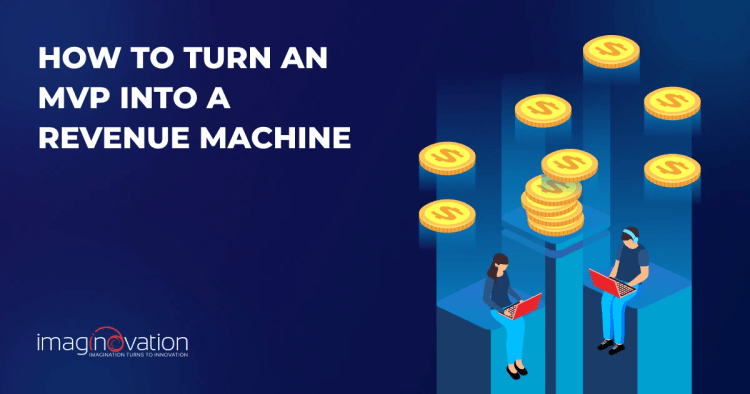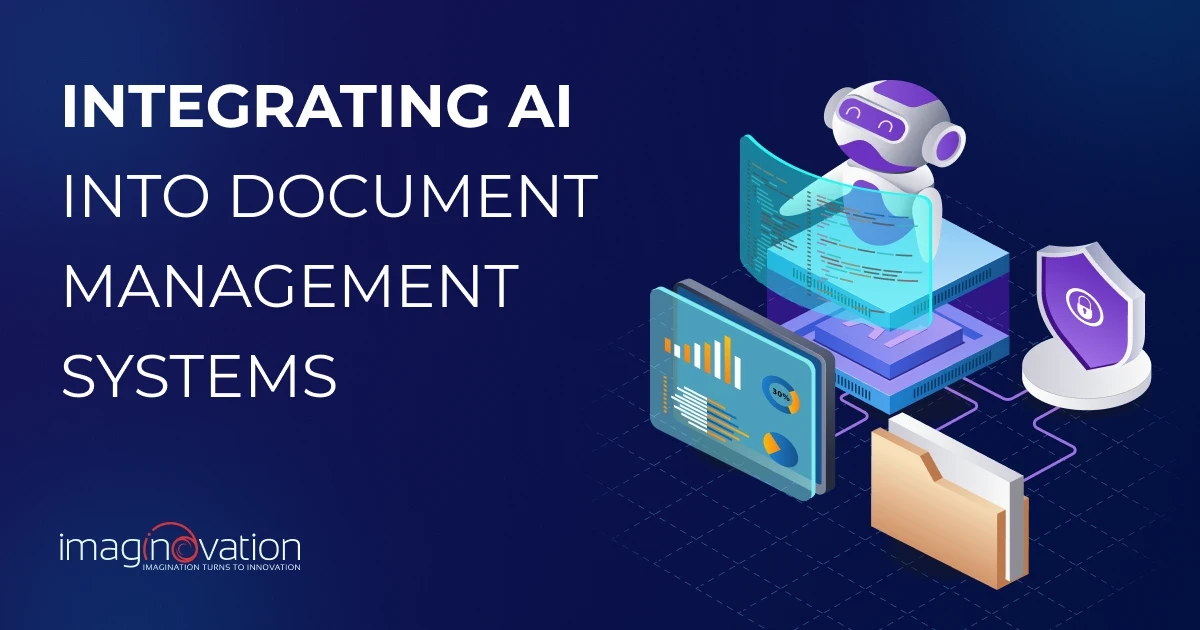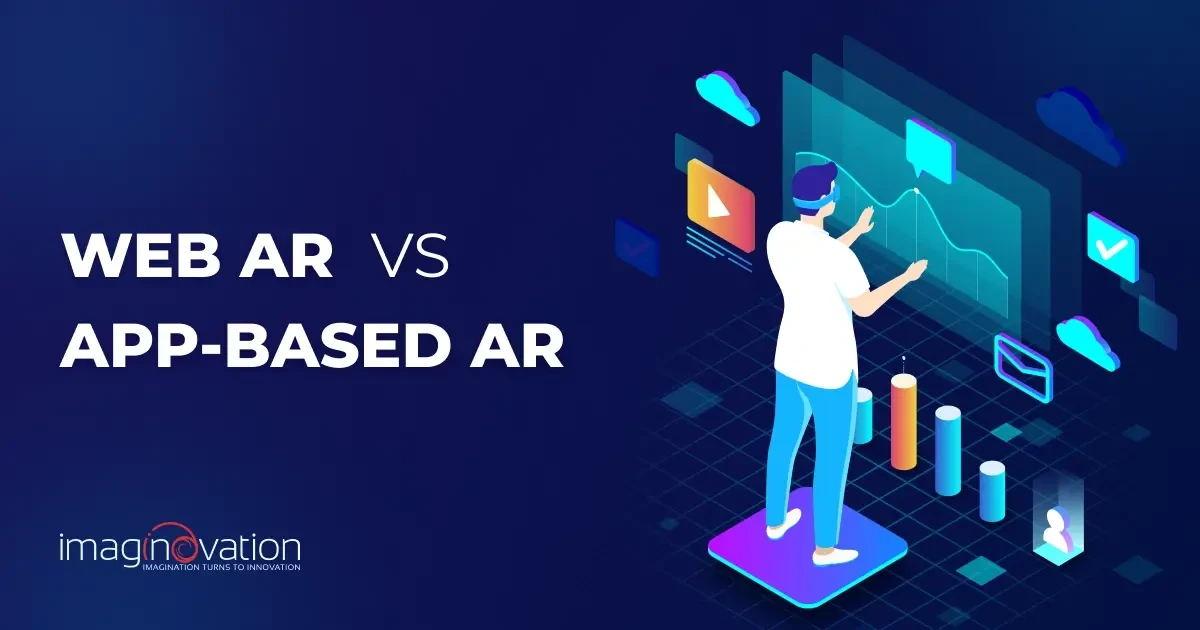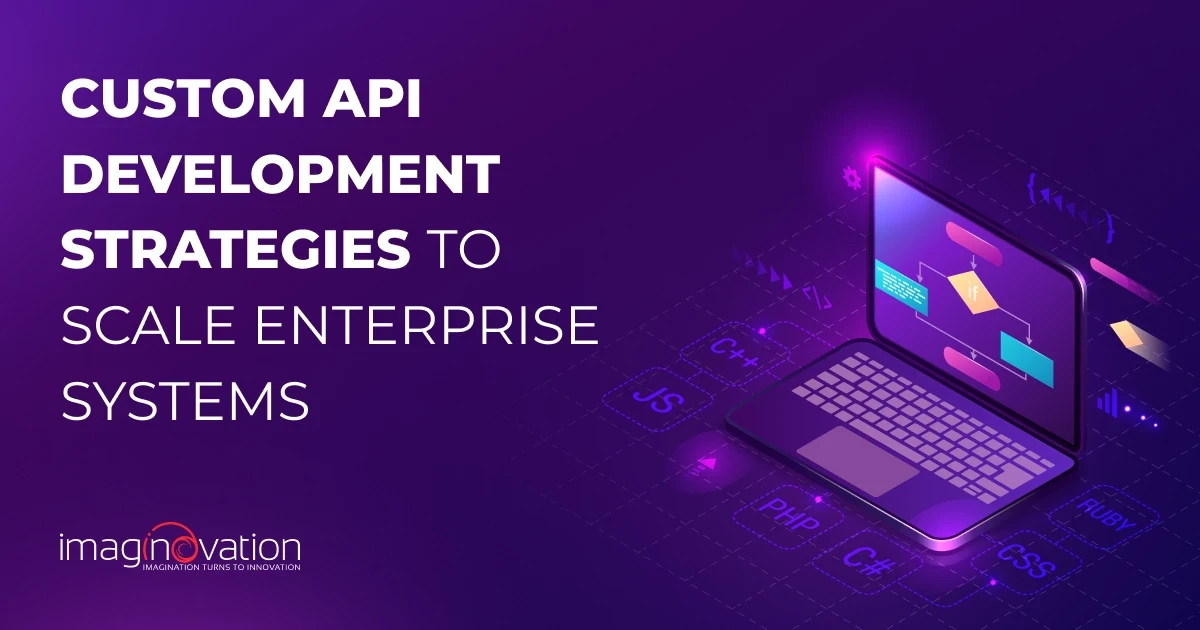Congratulations on launching your MVP. That’s a big milestone.
But here’s the real talk: the hardest (and most rewarding) part of your journey starts now.
Many founders assume that shipping the MVP means they’re halfway there. In truth, this is where the real work begins.
You see, most MVPs don’t fail at launch. They fail after.
Up to 70% of startups fail between years two and five. That’s the stage where they should be scaling and turning their MVP into a revenue-generating business.
So if you’ve just launched and are ready to grow, this guide is for you.
Let’s turn that MVP into a revenue machine.
Why Most MVPs Don’t Turn Into Real Products?
Here are some reasons why many MVPs fail to mature into robust products, particularly during the MVP-to-product and post-MVP development phases.
1. MVPs are built fast, but offer limited functionality.
MVPs are often built prioritizing speed over completeness.
While this approach helps test an idea quickly, it typically leads to minimal features, fragile codebases, and a lack of technical scalability.
As expectations and user numbers grow, these early shortcuts create severe bottlenecks during post-MVP development.
2. No product-market fit validation beyond early adopters.
Getting a thumbs-up from early users feels great. But stopping there is risky.
Many teams stop iterating after initial traction from early adopters. They skip feedback from broader customer segments and fail to validate it.
This limits growth and can mask critical flaws that emerge during the MVP-to-product transition, thereby preventing a proper market fit.
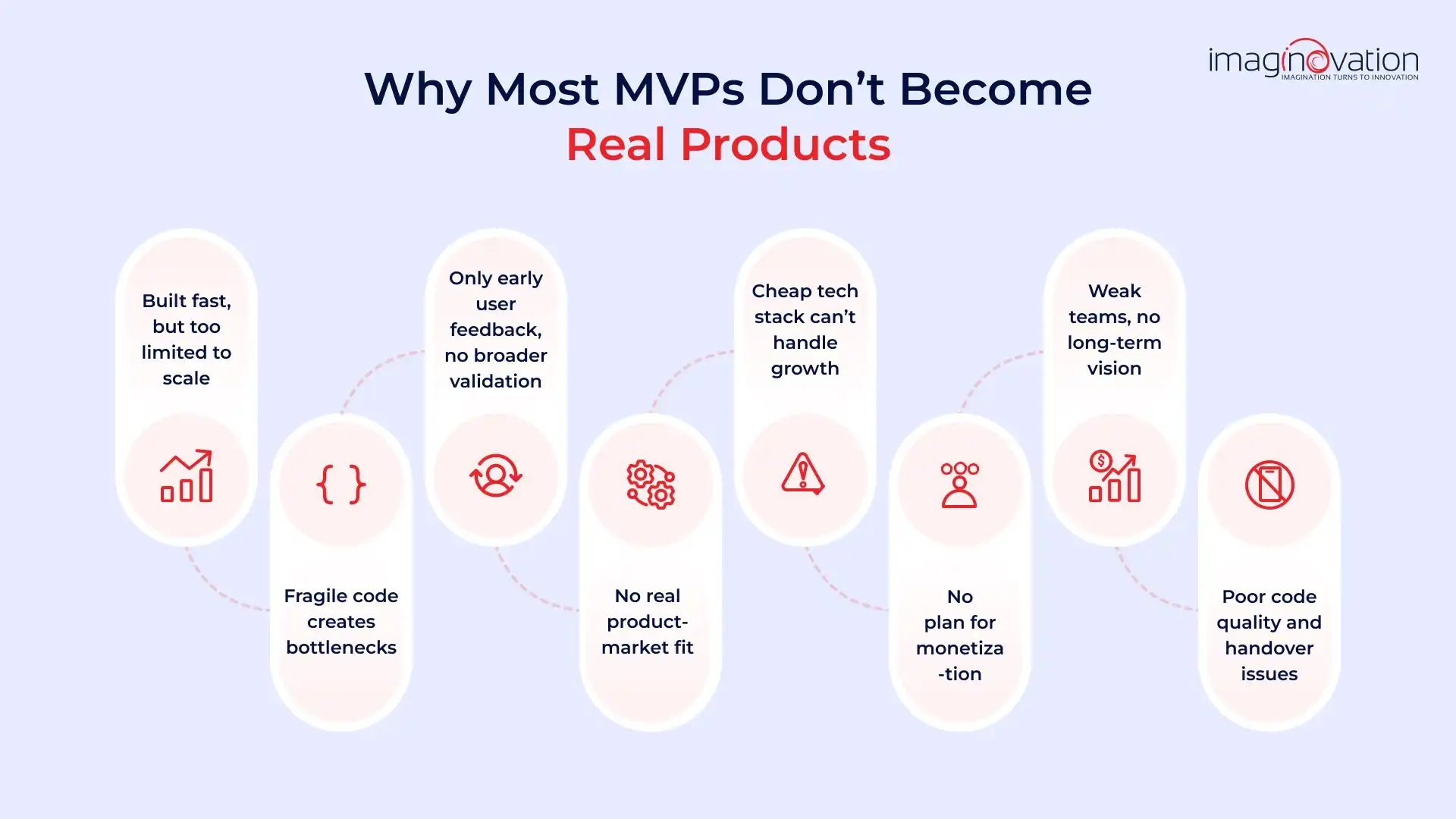
3. Lack of scalable architecture and monetization strategy.
Most MVPs are designed with a focus on speed, rather than scale.
Teams often use quick, low-cost tech stacks just to prove the idea works. However, what works for a small test app usually fails as the user base grows.
Moreover, there’s no plan to handle increased traffic, data, or features. In this case, performance drops, security gaps appear, and bugs accumulate.
Many MVPs also lack a clear way to make money. There’s no pricing model, no revenue strategy, and no roadmap to profitability.
As a result, the product stalls in the MVP phase, unable to scale or sustain itself.
4. Built by weak teams with no long-term product vision.
If your MVP is built by inexperienced freelancers or a junior team, it may not align with a long-term vision.
Future-proofing architectural choices is often overlooked. This creates challenges for ownership, code quality, and continuity in post-MVP development, which can slow or derail the evolution from MVP to product.
Also Read: Stuck After MVP Launch? You Need a Stronger Dev Team to Scale
From MVP to Product: What Needs to Change
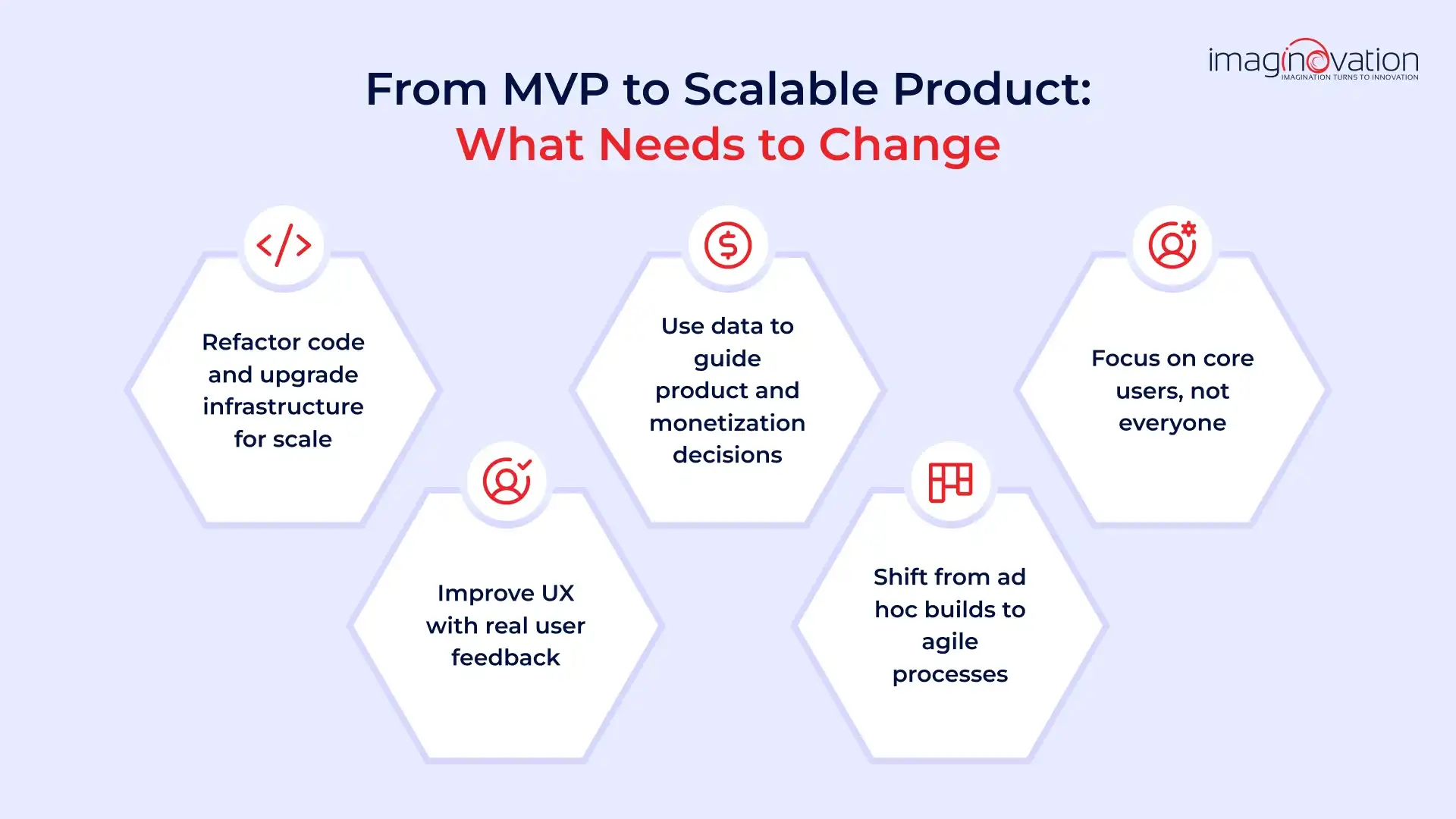
Building an MVP is just the beginning. True success comes when you focus on the MVP product growth.
Here’s how you can grow your MVP into a scalable, revenue-generating product.
1. Refactor and Strengthen your Tech
Refactor your MVP codebase
Early-stage MVPs are often built fast, which can lead to technical debt and fragile foundations.
To support long-term growth, invest time in:
- Refining the code to improve structure and readability
- Enhancing code quality for maintainability and performance
- Re-architecting for scalability so that the product can grow with demand
This not only cleans up the foundation but also makes your codebase easier to manage, evolve, and scale.
Also Read: Code Refactoring: A Complete Guide
Upgrade your infrastructure:
As your user base grows, your systems need to grow with it. Focus on:
- Cloud scalability to support dynamic loads
- Modular architecture for easier updates and feature expansion
- Robust database optimization to handle increasing data efficiently
- Agile team scaling to keep engineering velocity high as the team grows
These upgrades lay the foundation for a resilient, high-performing product that can handle real-world growth.
2. Build User-Centered Experiences (UX)
Validate and iterate with real user feedback. After launch, your focus shifts from just acquiring users to deeply understanding how they use the product. Put it in their hands and observe.
- Collect feedback from real usage, not assumptions
- Analyze interaction patterns to see what’s working and what’s not
- Focus on your core audience, the users you actually built it for
Reduce friction and confusion in user journeys. Feedback should directly inform experience improvements.
- Streamline onboarding so users get value fast
- Clarify workflows and reduce decision fatigue
- Polish your design to make key actions intuitive
The best product isn’t always the one with the most features — it’s the one that feels obvious and useful to your ideal users.
Iterate tightly. Achieving product-market fit rarely occurs in a single instance.
- Expect to rebuild flows and features
- Refine based on behavior, not just feedback
- Treat UX as an ongoing process, not a one-time task
3. Data: Make Analytics the Core of MVP Growth
Instrument your product with analytics. Don’t rely on gut feeling. Track everything that matters.
- Set up event tracking to capture user actions
- Use funnel analysis to understand drop-offs and conversion paths
- Build dashboards to monitor key performance indicators like usage, activation, churn, and retention
Let data guide your decisions. Real-time insights should shape what you build and fix.
- Test hypotheses based on actual user behavior
- Prioritize features that drive engagement and value
- Act on insights. If users are churning at onboarding, fix it; if a feature drives upgrades, invest more in it
Validate monetization. Traffic alone isn't growth; you need to know if users will pay.
- Test pricing models early, whether it’s subscription, pay-per-use, or freemium
- Identify value drivers and double down on what users are willing to pay for
4. Establish Agile, Scalable Processes instead of Ad hoc Builds
Move to agile iteration cycles:
Replace one-off builds with a more structured, goal-oriented approach.
- Run focused sprints with clear deliverables.
- Hold retrospectives to reflect and improve
- Maintain product roadmaps to align direction and priorities
Build strong feedback loops:
Make feedback part of every release and not just a checkpoint.
- Collect regular input from users and stakeholders
- Distinguish between feature requests and real pain points
- Translate insights into meaningful product decisions
Align teams to a unified product vision:
Scaling isn't just about adding features, but it requires alignment.
- Make sure tech and business teams are working toward the same goals
- Keep the vision front and center through every phase of development
- Create a culture of continuous improvement across the board
5. Other Key Shifts
Focus on the right users:
Don’t chase every user. “Getting it in the hands of users” should mean the right users, the ones your product was built for.
- Prioritize your core audience
- Optimize for depth of engagement, not just reach
Prepare for growth before it hits:
Don’t wait until you’re overwhelmed to start scaling.
- Strengthen systems and processes early.
- Build with the expectation that growth will stress-test everything
Strategies to Start Generating Revenue Post-MVP
Monetizing an MVP requires more than just activating a pricing plan. It requires active learning from users, continuous experiments, and steady improvements to what actually drives revenue.
Strategy #1 - Add Pricing Plans and Usage Tiers
Not every user needs the same thing. Some are just getting started. Others want the full power of your product.
That’s where clear pricing plans help.
Start with something simple, such as Basic, Pro, and Enterprise. This gives people options based on their needs and budgets.
Now, let’s talk usage tiers.
Usage tiers let you charge based on how much someone actually uses your product. Think of the number of users, transactions, storage, or API calls. Instead of one-size-fits-all pricing, you break things down by usage limits.
Casual users who need less don’t overpay. Power users who require more can upgrade to a higher tier. Everyone pays for what they use.
This setup helps you serve more users and test what they’re willing to pay for.
Pro tip: Make your entry tier free or very affordable to lower the barrier to adoption. Once users see value, upselling becomes much easier.
Strategy #2 - Build Premium Features Based on User Data
Put your analytics to work!
Observe how users interact with your MVP and identify which features keep them engaged and encourage them to return. These are your clues. Instead of guessing what to build next, let real usage data guide you.
Build premium or advanced features around these core experiences. If people consistently use a specific tool or request more control, that’s your opportunity.
Or, if users consistently reach a free usage limit or request integrations, consider offering these extras in a paid plan.
For example, Dropbox noticed users needed more storage and better sharing options, so they turned those into paid features.
Let your users show you what they’re willing to pay for.
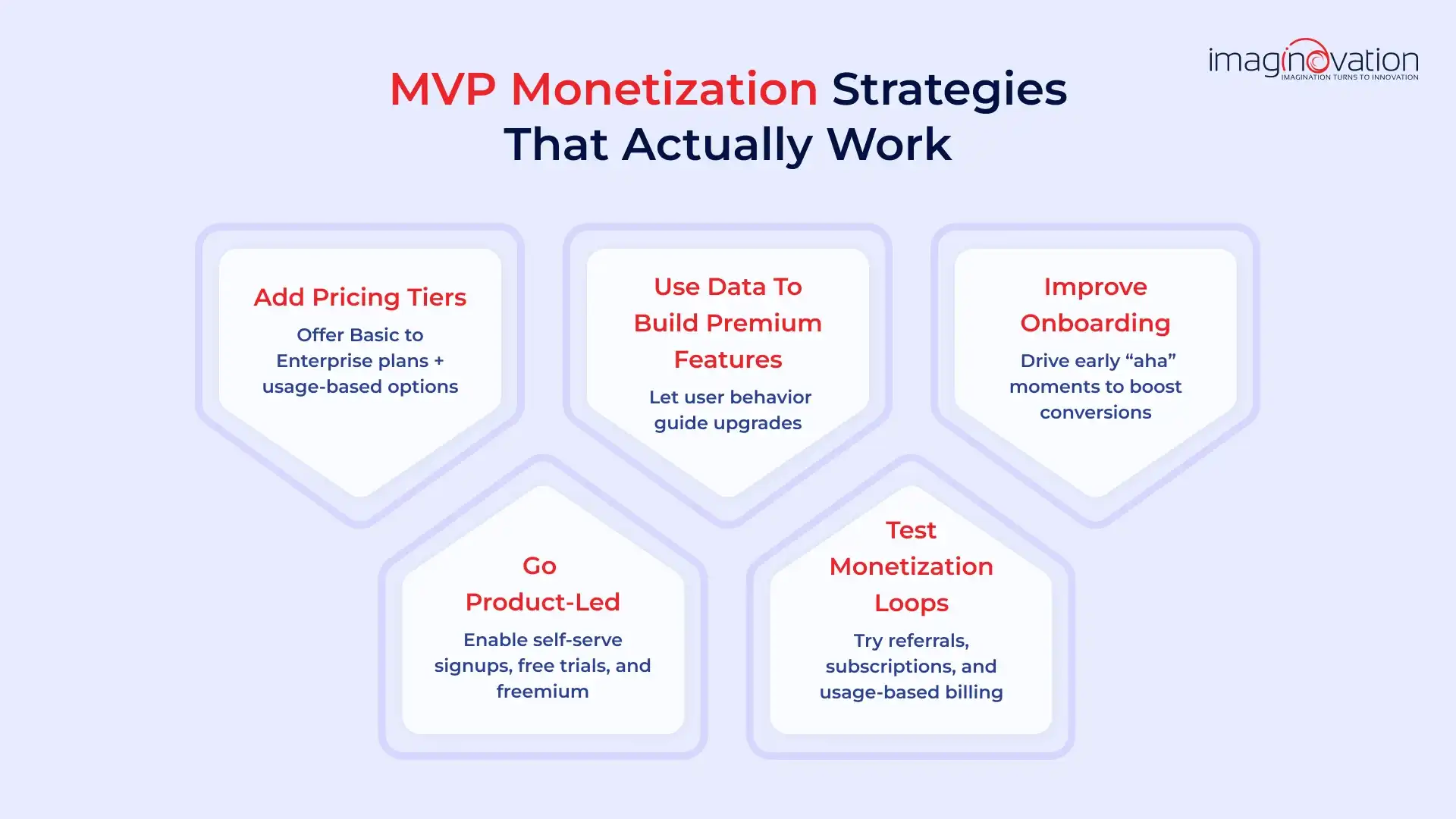
Strategy #3 - Implement Activation-Focused Onboarding
Effective onboarding helps users reach their “aha!” moment, the instant they realize why your product is worth sticking with.
A strong onboarding experience sets the stage for MVP monetization by ensuring users receive real value quickly.
How to do it?
Minimize friction at signup. Then, guide users to a quick win. Help them complete one valuable action early, such as sending their first message or uploading a file.
Use interactive guides, checklists, and tooltips to make the first steps clear and rewarding.
Personalization matters.
Tailor onboarding to user roles. A team lead may need a different path than an end user. Custom checklists or tooltips can make things more relevant and valuable.
Pro tip: A smooth, activation-focused onboarding flow not only boosts early engagement but also sets the stage for real monetization later.
Strategy #4 - Explore Product-Led Growth Channels
If you want to scale without hiring a big sales team, go product-led. Being product-led means your product drives growth. It brings in users. It keeps them coming back. It sells itself.
Let people sign up, try, and explore your product on their own. Self-serve signups, free trials, demo accounts, and freemium plans allow them to experience value at their own pace. There's no pressure, no demos; just hands-on discovery.
How to do it?
Remove friction. Let users get started fast. Offer trial access to key features. Add helpful nudges like in-app tours, tooltips, and an easy-to-search help center. Keep guidance available 24/7.
Why does it work?
When users see value on their terms, they’re more likely to stick around and upgrade. This reduces acquisition costs and helps you grow faster, without the need for a large sales team.
For example, companies like Slack and Atlassian drove MVP to revenue primarily through viral, low-friction self-serve onboarding and expansions. (Source)
Strategy #5 - Test Monetization Loops
Want to turn your MVP into a real money-maker?
Start testing different ways to earn. Think of it like running small, real-world experiments. Try out referral perks, flexible billing, or subscription plans. Let the best model emerge through user behavior.
Try referral rewards. Let your happy users spread the word. Give them a reason to bring others in. Referral programs can lower your customer acquisition costs and boost retention.
Experiment with subscription plans. Monthly or yearly subscriptions give you steady revenue. It’s the go-to model for most SaaS businesses for a reason. It makes cash flow predictable and lets you focus on keeping users happy.
Over 60% of SaaS companies rely on subscriptions as their primary source of revenue.
Offer usage-based billing. Let customers pay based on their usage. This works well for both growing startups and large enterprises. It gives flexibility and makes your product more accessible.
Keep tweaking. Not every idea will work right away. A referral campaign might flop in a niche B2B market.
But a flexible usage plan might catch on. So run quick pilots. Launch a test plan. Offer a referral deal. Watch what clicks and build from there.
Real-World Example: Everflex
We applied the same framework shared above to help build and launch Everflex — a clinic management platform that began as a simple MVP and evolved into a fully developed product now used by physical therapy providers across the United States.
Every phase followed the strategies we’ve outlined in this post.
From refining the user experience and adding the right features to validating monetization and preparing for scale, the process was grounded in real user feedback and focused on iterative improvements.
👉 Read the full case study to see how we helped Everflex grow from MVP to a scalable, revenue-generating platform.
Choosing the Right Partner for Post-MVP Success
Post-MVP success isn’t just about shipping features. It’s about working with a team that understands your product vision, helps you scale, and stays in the game beyond launch.
You don’t just need developers. You need a partner who thinks like a product owner.
Here’s what to look for:
- Strategic thinking:
A good partner helps shape your roadmap using real user insights, rather than relying on gut instinct or guesswork. - Scalability planning
They should design systems that grow with you, from infrastructure and features to user support. - Ongoing support
Post-launch, things move fast. You need a team that’s available, responsive, and ready to handle bugs, iterations, and feedback. - Collaborative mindset
The best partners challenge your thinking, ask the right questions, and care about your outcomes, not just your backlog.
And what to avoid:
- Saying yes to everything, without asking why
- Prioritizing speed over long-term sustainability
- Avoiding discussions about scaling or support
- Disappearing after handoff
- Overpromising and underdelivering
- Offering little visibility into process or progress
- Treating you like a one-off project, not a long-term partner
These are signs of a short-term, code-only mindset, not a team that will help you go beyond MVP.
Why Long-Term Thinking Matters
Choosing the cheapest vendor may save money upfront, but it often leads to bigger problems later: missed growth opportunities, technical debt, rework, and slow response to change.
A true product growth partner will:
- Understand your market and your users
- Build with continuity, not shortcuts
- Help you avoid costly rebuilds down the road
- Stay aligned as your product evolves
- Keep you agile and adaptable when the market shifts
Investing in the right partner isn’t just smart, it’s essential for building something that lasts.
Conclusion
An MVP is just the starting point. Turning a product into a success takes more than just features. It requires focus, smart execution, and a clear plan for growth.
If you're ready to take that next step, the team at Imaginovation is here to help. We've worked with startups to evolve early-stage products into scalable, revenue-generating solutions.
Book a free consultation and let's build something your users truly value.
Ready to build an app, but not sure where to start?
We've got you covered. Click the button below to get started.

